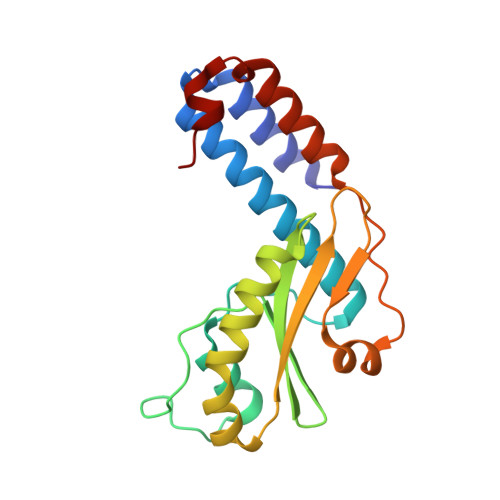Biophysical and structural study of La Crosse virus endonuclease inhibition for the development of new antiviral options.
Feracci, M., Hernandez, S., Garlatti, L., Mondielli, C., Vincentelli, R., Canard, B., Reguera, J., Ferron, F., Alvarez, K.(2024) IUCrJ 11: 374-383
- PubMed: 38656310
- DOI: https://doi.org/10.1107/S205225252400304X
- Primary Citation of Related Structures:
7OA4, 7PLR - PubMed Abstract:
The large Bunyavirales order includes several families of viruses with a segmented ambisense (-) RNA genome and a cytoplasmic life cycle that starts by synthesizing viral mRNA. The initiation of transcription, which is common to all members, relies on an endonuclease activity that is responsible for cap-snatching. In La Crosse virus, an orthobunyavirus, it has previously been shown that the cap-snatching endonuclease resides in the N-terminal domain of the L protein. Orthobunyaviruses are transmitted by arthropods and cause diseases in cattle. However, California encephalitis virus, La Crosse virus and Jamestown Canyon virus are North American species that can cause encephalitis in humans. No vaccines or antiviral drugs are available. In this study, three known Influenza virus endonuclease inhibitors (DPBA, L-742,001 and baloxavir) were repurposed on the La Crosse virus endonuclease. Their inhibition was evaluated by fluorescence resonance energy transfer and their mode of binding was then assessed by differential scanning fluorimetry and microscale thermophoresis. Finally, two crystallographic structures were obtained in complex with L-742,001 and baloxavir, providing access to the structural determinants of inhibition and offering key information for the further development of Bunyavirales endonuclease inhibitors.
Organizational Affiliation:
Université Aix-Marseille, Architecture et Fonction des Macromolécules Biologiques (AFMB)-UMR7257 CNRS-Case 932, 163 Avenue de Luminy, 13288 Marseille CEDEX 09, France.


















